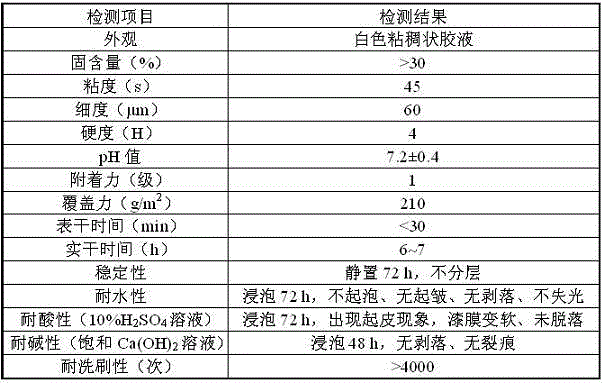Novel process for preparing emulsion paint through waste polystyrene plastic
A polystyrene plastic, waste polystyrene technology, applied in latex paints, rosin coatings, coatings, etc., can solve the problems of poor film-forming properties and adhesion of latex paints, strong irritation, high cost, and achieve good chemical Effects of stability and mechanical properties, low toxicity, and low production costs
- Summary
- Abstract
- Description
- Claims
- Application Information
AI Technical Summary
Problems solved by technology
Method used
Image
Examples
Embodiment 1
[0026] Example 1 A kind of new technology that utilizes waste polystyrene plastics to prepare latex paint, comprises the following steps:
[0027] (1) Soak the waste polystyrene plastic in lime water with a temperature of 15°C and a mass concentration of 0.10% for 50 minutes, and take it out after mechanical stirring for 8 minutes, and then wash it twice with clean water to remove the stained oil and impurities. Get clean polystyrene plastic.
[0028] (2) Dry the clean polystyrene plastic at a temperature of 35°C or air-dry it and then pulverize it to obtain polystyrene particles with a particle size of 0.3 cm.
[0029] (3) Add 45 g of polystyrene particles to the heavy aromatic oil per 100 mL of heavy aromatic oil, stir and dissolve into a homogeneous phase, and then filter to obtain the filtrate.
[0030] (4) Add 8.5 g of polyvinyl acetate and 3.2 g of rosin to the filtrate successively for every 100 mL of filtrate, and then heat and stir at a temperature of 70°C until...
Embodiment 2
[0037] Example 2 A kind of new technology that utilizes waste polystyrene plastics to prepare latex paint, comprises the following steps:
[0038] (1) Soak the waste polystyrene plastic in lime water with a temperature of 25°C and a mass concentration of 0.10% for 60 minutes, take it out after mechanical stirring for 5 minutes, and then wash it twice with clean water to remove the stained oil and impurities. Clean polystyrene plastic.
[0039](2) Dry the clean polystyrene plastic at a temperature of 25°C or dry it and then pulverize it to obtain polystyrene particles with a particle size of 0.1 cm.
[0040] (3) Add 45 g of polystyrene particles to the heavy aromatic oil per 100 mL of heavy aromatic oil, stir and dissolve into a homogeneous phase, and then filter to obtain the filtrate.
[0041] (4) Add 8.5 g of polyvinyl acetate and 3.2 g of rosin to the filtrate successively for every 100 mL of filtrate, and then heat and stir at a temperature of 50° C. until the react...
Embodiment 3
[0048] Example 3 A kind of new technology that utilizes waste polystyrene plastics to prepare latex paint, comprises the following steps:
[0049] (1) Soak the waste polystyrene plastic in lime water with a temperature of 20°C and a mass concentration of 0.10% for 55 minutes, and take it out after mechanical stirring for 6 minutes, and then wash it twice with clean water to remove the stained oil and impurities. Get clean polystyrene plastic.
[0050] (2) Dry the clean polystyrene plastic at a temperature of 30°C or dry it and then pulverize it to obtain polystyrene particles with a particle size of 0.2 cm.
[0051] (3) Add 45 g of polystyrene particles to the heavy aromatic oil per 100 mL of heavy aromatic oil, stir and dissolve into a homogeneous phase, and then filter to obtain the filtrate.
[0052] (4) Add 8.5 g of polyvinyl acetate and 3.2 g of rosin to the filtrate successively for every 100 mL of filtrate, and then heat and stir at a temperature of 60° C. until ...
PUM
| Property | Measurement | Unit |
|---|---|---|
| Particle size | aaaaa | aaaaa |
| Particle size | aaaaa | aaaaa |
| Particle size | aaaaa | aaaaa |
Abstract
Description
Claims
Application Information
 Login to View More
Login to View More - R&D
- Intellectual Property
- Life Sciences
- Materials
- Tech Scout
- Unparalleled Data Quality
- Higher Quality Content
- 60% Fewer Hallucinations
Browse by: Latest US Patents, China's latest patents, Technical Efficacy Thesaurus, Application Domain, Technology Topic, Popular Technical Reports.
© 2025 PatSnap. All rights reserved.Legal|Privacy policy|Modern Slavery Act Transparency Statement|Sitemap|About US| Contact US: help@patsnap.com

